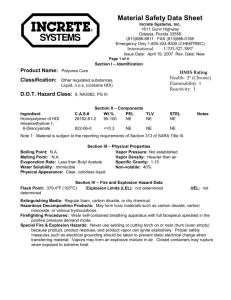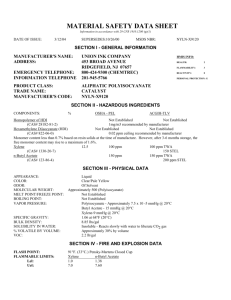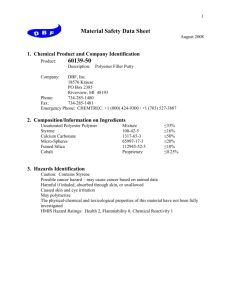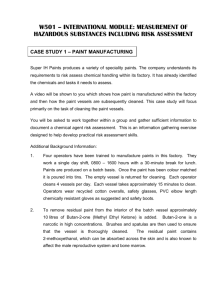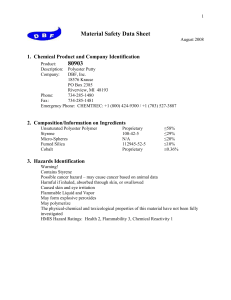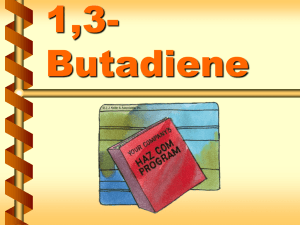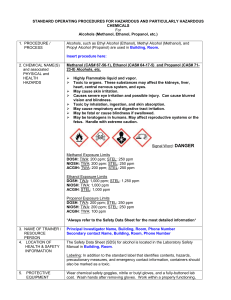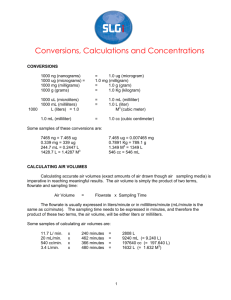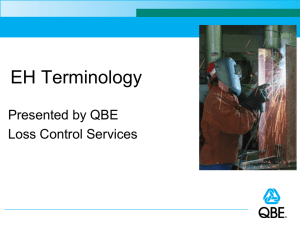LowViscoUrethaneC
advertisement
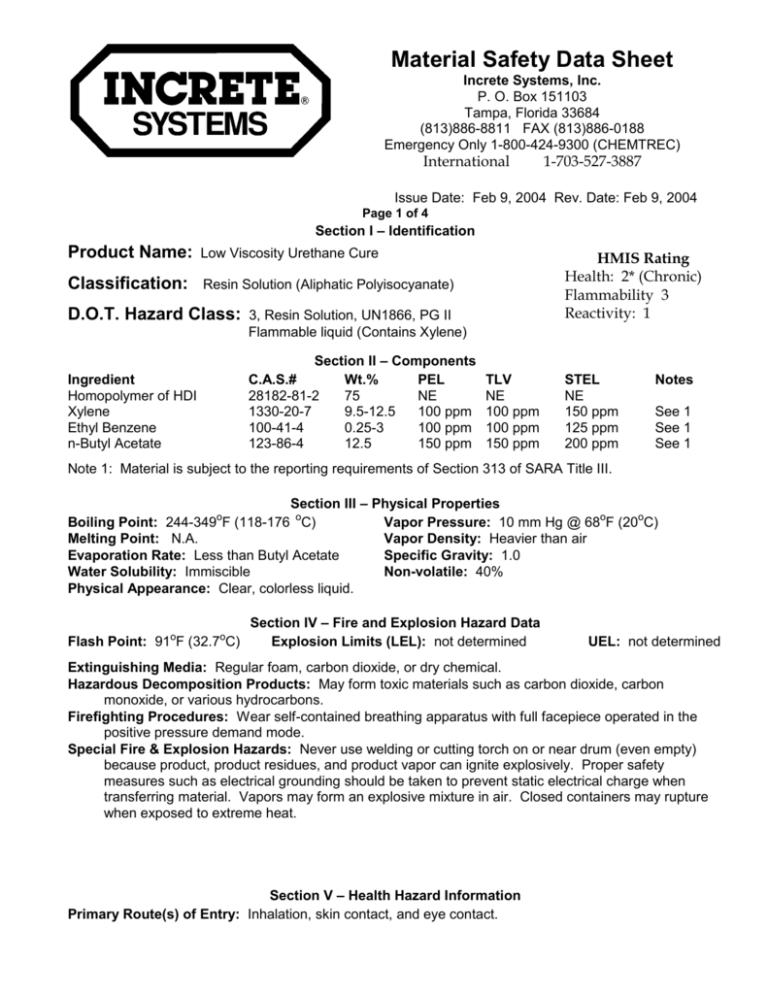
Material Safety Data Sheet Increte Systems, Inc. P. O. Box 151103 Tampa, Florida 33684 (813)886-8811 FAX (813)886-0188 Emergency Only 1-800-424-9300 (CHEMTREC) International 1-703-527-3887 Issue Date: Feb 9, 2004 Rev. Date: Feb 9, 2004 Page 1 of 4 Section I – Identification Product Name: Low Viscosity Urethane Cure Classification: Resin Solution (Aliphatic Polyisocyanate) D.O.T. Hazard Class: 3, Resin Solution, UN1866, PG II Flammable liquid (Contains Xylene) Section II – Components C.A.S.# Wt.% PEL 28182-81-2 75 NE 1330-20-7 9.5-12.5 100 ppm 100-41-4 0.25-3 100 ppm 123-86-4 12.5 150 ppm Ingredient Homopolymer of HDI Xylene Ethyl Benzene n-Butyl Acetate HMIS Rating Health: 2* (Chronic) Flammability 3 Reactivity: 1 TLV NE 100 ppm 100 ppm 150 ppm STEL NE 150 ppm 125 ppm 200 ppm Notes See 1 See 1 See 1 Note 1: Material is subject to the reporting requirements of Section 313 of SARA Title III. Section III – Physical Properties Boiling Point: 244-349 F (118-176 oC) Vapor Pressure: 10 mm Hg @ 68oF (20oC) Melting Point: N.A. Vapor Density: Heavier than air Evaporation Rate: Less than Butyl Acetate Specific Gravity: 1.0 Water Solubility: Immiscible Non-volatile: 40% Physical Appearance: Clear, colorless liquid. o Flash Point: 91oF (32.7oC) Section IV – Fire and Explosion Hazard Data Explosion Limits (LEL): not determined UEL: not determined Extinguishing Media: Regular foam, carbon dioxide, or dry chemical. Hazardous Decomposition Products: May form toxic materials such as carbon dioxide, carbon monoxide, or various hydrocarbons. Firefighting Procedures: Wear self-contained breathing apparatus with full facepiece operated in the positive pressure demand mode. Special Fire & Explosion Hazards: Never use welding or cutting torch on or near drum (even empty) because product, product residues, and product vapor can ignite explosively. Proper safety measures such as electrical grounding should be taken to prevent static electrical charge when transferring material. Vapors may form an explosive mixture in air. Closed containers may rupture when exposed to extreme heat. Section V – Health Hazard Information Primary Route(s) of Entry: Inhalation, skin contact, and eye contact. LV Urethane Cure MSDS, Page 2 of 4 Effects of Acute Overexposure: Eyes – May cause mild eye irritation. Symptoms may include stinging, tearing, and redness. Skin – Exposure can cause defatting of tissue leading to dryness, redness, burning and cracking. Pre-existing skin conditions can be aggravated by exposure to this product. Respiratory – Overexposure can cause difficulty with breathing and shortness of breath as well as irritation to the nose, throat, and respiratory tract. Extreme exposure will also cause central nervous system depression with the possibility of dizziness, drowsiness, nausea, headache, and unconsciousness. Pre-existing respiratory conditions can be aggravated by exposure to this product. Ingestion – Single dose oral toxicity is low, and unlikely to occur with normal handling. Symptoms will include gastrointestinal irritation (nausea, vomiting, diarrhea), and central nervous system depression (dizziness, drowsiness, nausea, headache, unconsciousness). First Aid: Eyes – Flush gently with water. If symptoms persist or vision is impaired, seek medical attention. Skin – Remove contaminated clothing, flush exposed area with large amounts of water. If skin is damaged or symptoms of irritation persist, seek medical attention. Respiratory – Remove individual to fresh air immediately. If unconscious, begin artificial respiration. Seek medical attention. Ingestion – DO NOT induce vomiting. Keep individual warm and quiet. If symptoms include unconsciousness or drowsiness, place individual on his left side with his head down. Seek medical attention. Effects of Chronic Overexposure: No components of this material have been identified as carcinogenic. Intentional misuse of this product by deliberate inhalation has been shown to cause liver, kidney, brain damage and death. Toluene and xylene (two components of this material) have been shown to cause fetal defects in laboratory animal studies, however the relevance of these findings to humans is uncertain. Repeated and prolonged overexposure to products similar to this material has been associated with cardiac arrhythmia and permanent brain and nervous system damage. Section VI – Chemical Reactivity Stability: Material is stable. Hazardous Polymerization: May occur; Contact with moisture or other materials which react with isocyanates or temperatures over 400F (204C) may cause polymerization. Incompatibility: Water, amines, strong bases, acids, combustible material, alcohols, metal compounds and surface active materials. Conditions to Avoid: Warm storage and ignition sources. Hazardous Decomposition Products: Incomplete combustion produces carbon monoxide and carbon dioxide. Section VII – Spill Procedures Small Spill: Absorb spilled product onto inert absorbent material. Large Spill: Remove all sources of ignition, ventilate area. Dike area to prevent material from entering sewer or water supplies. Wear protective equipment during cleanup. Absorb spilled product with an inert absorbent material (sawdust, vermiculite, sand, etc.), and place in closed containers. This material contains the following ingredients which, if spilled or released in quantities equal to or greater than the Reportable Quantity (RQ), are subject to the reporting requirements of CERCLA and/or SARA (40 CFR Parts 302, 355): Xylene RQ Value = 1000 pounds Ethyl Benzene RQ Value = 1000 pounds LV Urethane Cure MSDS, Page 3 of 4 Waste Disposal Method: Dispose of material in a manner consistent with local, state and federal law. For further information, contact your state or local waste agency or the United States Environmental Protection Agency's RCRA hotline (1-800-424-9346). Section VIII – Special Protection Information Required Work/Hygiene Procedures: Precautions must be taken so that persons handling this product do not allow contact with the eyes or skin. In spray operations, protection must be afforded against exposure to both vapor and spray mist. Eye Protection: Wear face-shield or chemically-resistant goggles. Skin Protection: Permeation resistant gloves (butyl rubber, nitrile rubber) Based on laboratory assessment tests it is recommended that latex gloves not be worn when working with isocyanates. Cover as much of the exposed skin area as possible with appropriate clothing (long sleeve shirts, etc.). If skin creams are used, keep the area protected only by the cream to a minimum. Ventilation: Good industrial hygiene practice dictates that worker protection should be achieved through engineering controls such as ventilation, whenever feasible. When such controls are not feasible to achieve full protection, the use of respirators and other personal protective equipment is mandated. (See respirator requirements below). Exhaust air may need to be cleaned by scrubbers or filters to reduce environmental contamination. Respiratory Protection: A respirator that is recommended or approved for use in isocyanate-containing environments (air-purifying or fresh air-supplied) may be necessary for sprya applications or other situations such as high temperature use, which may produce inhalation exposures. A supplied-air respiratior (either positive pressure or continuous flow-type) is recommended. Before an airpurifying respirator can be used, air monitoring must b eperformmed to measure airborne concentrations of HDI polyisocyanate. Specific conditions under which air-purifying respirators can be used are outlined in the following sections. Observe OSHA regulations for respirator use (29 CFR 1910.134) Spray Application: A. Good industrial hygene practice dictates that when isocyanate-based coatings are spray applied, some form of respiratory protection should be worn. During the spray application of coatings containing this product, the use of a supplied-air (either positive pressure or continuous flowtype) respirator is mandatory when ONE or MORE of the following conditions exists: 1) the airborne isocyanate concentrations are not known; or 2) the airborne isocyanate concentrations exceed 0.05 ppm averaged over 8 hours (10 times the 8-hour TWA exposure limit); or 3) the airborne polyisocyanate (polymeric, oligomeric) concentrations exceed 5 mg/m3 averaged over 8 hours or 10 mg/m3 averaged over 15 minutes (10 times the 8-hour TWA or the 15-minute STEL exposure limits); or 4) operations are performed in a confined space (See OSHA Confined Space Standard, 29 CFR 1910.146). B. A properly fitted air-purifying (combination organic vapor and particulate) respirator, proven by test to be effective in isocyanate-containing spray paiint environments, and used in accordance with all recommendation made by the manufacturer, can be sued when ALL of the following conditions are met: 1) the air airborne isocyanate monomer concentrations are known to be less than 0.05 ppm averaged over 8 hours (10 times the 8-hour TWA exposure limit); and 2) the airborne polyisocyanate (polymeric, oligomeric) concentrations are known to be below 5 mg/m3 averaged over 8 hours or 10 mg/m3 averaged over 15 minutes (10 times the 8-hour TWA or the 15-minute STEL exposure limits); and 3) a NIOSH-certified End of Service Life Indicator or change schedule based upon objective information or data is used to insure that cartriges are replaced before the end of their service life. In addition, prefilters should be changed whenever breating resistance increases due to particulate buildup. Non-Spray operations: A. During non-spray applications such as mixing, batch-making, brush or roller applicatoin, etc., at elevated temperatures (for example heating of material or application to a hot substrate), it is possible to be exposed to airborne isocyanate vapors. Therefore, when the coatings system will LV Urethane Cure MSDS, Page 4 of 4 be applied in a non-spray manner, a supplied-air (either positive pressure or continuous flow-type) is mandatory when ONE or MORE of the following conditions exists: 1) the airborne isocyanate concentrations are not known; or 2) the airborne isocyanate concentrations exceed 0.05 ppm averaged over 8 hours (10 times the 8-hour TWA exposure limit); or 3) the airborne polyisocyanate (polymeric, oligomeric) concentrations exceed 5 mg/m3 averaged over 8 hours or 10 mg/m3 averaged over 15 minutes (10 times the 8-hour TWA or the 15-minute STEL exposure limits); or 4) operations are performed in a confined space (See OSHA Confined Space Standard, 29 CFR 1910.146). B. A properly fitted air-purifying (combination organic vapor and particulate) respirator, proven by test to be effective in isocyanate-containing spray paiint environments, and used in accordance with all recommendation made by the manufacturer, can be sued when ALL of the following conditions are met: 1) the air airborne isocyanate monomer concentrations are known to be less than 0.05 ppm averaged over 8 hours (10 times the 8-hour TWA exposure limit); and 2) the airborne polyisocyanate (polymeric, oligomeric) concentrations are known to be below 5 mg/m3 averaged over 8 hours or 10 mg/m3 averaged over 15 minutes (10 times the 8-hour TWA or the 15-minute STEL exposure limits); and 3) a NIOSH-certified End of Service Life Indicator or change schedule based upon objective information or data is used to insure that cartriges are replaced before the end of their service life. In addition, prefilters should be changed whenever breating resistance increases due to particulate buildup. Other Protective Equipment: Wear appropriate work clothing to prevent skin contact. Wash before reuse. Eye wash station and safety shower should be available. Section IX – Special Precautions Handling and Storing: Avoid prolonged or repeated inhalation of heated vapors or spray mists. Keep away from heat or open flame. Avoid prolonged or repeated skin contact. Containers of this material may be hazardous when emptied. Treat empty containers with the same hazard precautions given in this data sheet. Section X – Supplemental Information SARA Title III – Section 313 Listed Ingredients: The following ingredients in this product are subject to the reporting requirements of Section 313 of SARA and 40 CFR 372 (see Section II of this document for percentages of ingredients: Hexamethyl Diisocyanate (822-06-0) xylene (1330-20-7) n-butyl acetate (123-86-4) ethyl benzene (100-41-4) SARA Title III – Section 311/312 Hazard Classifications. This product is rated as a Fire Hazard, an Immediate (acute) Health Hazard, and a Delayed (chronic) Health Hazard. This information is provided in good faith and is correct to the best knowledge of Increte Chemical Company, Inc. Increte Chemical Co., Inc. makes no representation as to its completeness or accuracy. Customers are encouraged to make their own determination as to the suitability of this product for their purpose prior to use. Increte Chemical Co., Inc. disclaims responsibility for damages of any kind resulting from the use of this information. No warranty of merchantability, fitness for use, or any other warranty is expressed or is to be implied regarding the accuracy of these data.
